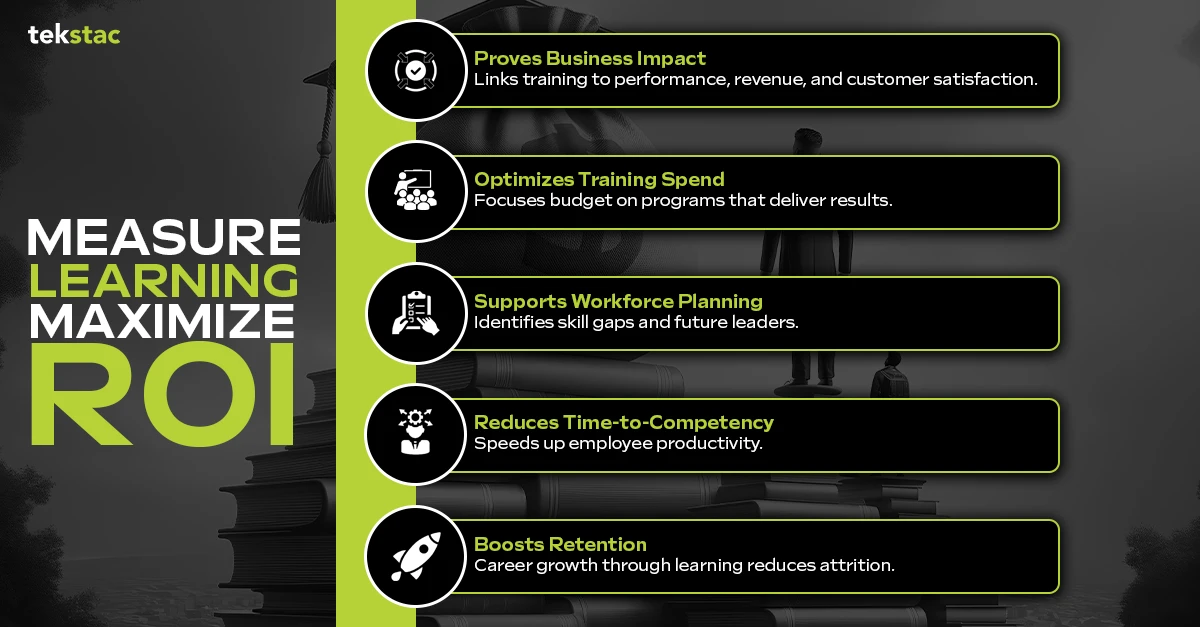How Tekstac Skills Assessments Improve Learning Outcomes and Drive ROI

“If you can’t measure it, you can’t improve it.” This simple truth is the foundation of modern learning and development strategies. As organizations channel time, effort, and resources into upskilling and reskilling their people, the focus has decisively shifted from activity to impact. It is no longer enough to know that a course was completed, or a training was attended; stakeholders want to understand what the learner gained. This is where Learning Outcomes come into play.
What Are Learning Outcomes? Definition & Importance
Learning outcomes are the specific skills, knowledge, attitudes, and competencies that a learner is expected to acquire as a result of a learning experience. Unlike learning objectives, which describe what the instructor aims to teach, learning outcomes describe what the learner can do after the training. These outcomes are measurable and actionable, making them essential for evaluating learning effectiveness.
Examples of learning outcomes include:
- A marketing executive being able to analyze customer segmentation data.
- A programmer demonstrating secure coding practices.
- A manager applying emotional intelligence in team interactions.
Why Measuring Learning Outcomes Matters for Organizations
Organizations invest millions in learning and development each year. But without concrete measurement, these initiatives risk becoming superficial. Here are some key reasons why measuring learning outcomes is critical:
1. Validates Learning Effectiveness
Measuring outcomes helps determine whether a training initiative led to improved skills or behavior change. This validation ensures that learning is meaningful, not just procedural.
2. Enables Personalization and Continuous Improvement
Assessment of learning outcomes helps identify skill gaps, enabling personalized learning paths. For instance, if a learner struggles with a certain concept, targeted content or support can be introduced. Over time, this leads to continuous improvement in both learning content and learner performance.
3. Aligns Learning with Business Goals
When learning outcomes are tied to business objectives (like improved customer satisfaction, increased productivity, or reduced error rates), it creates alignment between individual development and organizational success.
4. Drives Accountability
In today’s data-driven world, L&D departments are increasingly accountable for delivering measurable results. Outcomes-based measurement offers transparency and builds credibility with stakeholders.
5. Informs ROI Calculations
You can’t demonstrate ROI without data. Measuring learning outcomes provides the metrics needed to correlate learning interventions with business impact, making it possible to justify or even expand the L&D budget.
The Shift Toward Data-Driven Learning Outcomes Measurement
Traditional learning measurement methods, such as tracking attendance and course completion, are giving way to more sophisticated, data-rich approaches. Organizations now leverage data analytics to capture granular insights into learner performance, progression, and engagement.
This shift is fueled by the increasing availability of digital learning platforms and AI-driven tools that collect, process, and analyze learning behavior in real-time. Predictive analytics, adaptive assessments, and learning experience platforms (LXPs) are transforming how we measure success. By using data to continuously evaluate and refine learning interventions, organizations ensure that every learning dollar is spent strategically.
According to a Deloitte survey, 61% of high-performing organizations use data analytics to support learning strategy development- more than double the rate of their lower-performing peers.
How Learning Outcomes Connect to Business ROI
The ultimate goal of measuring learning outcomes is to prove—and improve—return on investment (ROI). Here’s how outcomes data directly impacts ROI:

1. Demonstrating Business Impact
Clear outcomes link learning efforts to key business metrics such as employee performance, customer satisfaction, and innovation speed. For example, improved sales training outcomes can be measured against increased revenue or shorter sales cycles.
2. Optimizing Training Spend
Outcome data helps identify high- and low-performing programs, enabling better budget allocation. By cutting ineffective initiatives and scaling successful ones, organizations maximize learning ROI.
3. Supporting Workforce Planning
By measuring outcomes, organizations can identify future leaders, skill shortages, and team strengths. This enables proactive talent management and succession planning.
4. Reducing Time-to-Competency
Effective training backed by measurable outcomes shortens the time it takes for employees to reach full productivity, accelerating ROI.
5. Boosting Employee Retention and Engagement
Employees who see real career progression through skill development are more engaged and less likely to leave, significantly reducing attrition costs.
Modern Methods to Measure Learning Outcomes Effectively
Many organizations still rely on traditional methods like attendance tracking, course completion rates, or post-training feedback forms. While useful for gauging engagement or satisfaction, these methods do not assess skill application or knowledge retention.
Modern approaches include:
- Formative and summative assessments: Conducted before, during, and after learning to evaluate comprehension.
- Simulation-based assessments: Providing real-world scenarios to test applied skills.
- Project-based evaluations: Where learners are required to submit real or simulated work relevant to their job roles.
- 360-degree feedback and peer assessments: Offering a more holistic view of behavioral and performance outcomes.
- AI-driven analytics: Delivering personalized insights into learner strengths and gaps.
The Business Impact of Learning Outcomes Measurement
1. Improved Decision-Making
When you have clear data on what works and what doesn’t, you can make better decisions about content, delivery methods, and resource allocation.
2. Better Learner Engagement
Learners who see a direct link between their efforts and career growth are more motivated. Measurable outcomes act as milestones that validate progress.
A McKinsey study reveals that only 40% of companies align learning strategies with business objectives, underscoring the need for clearer measurement frameworks that connect learning outcomes to performance and ROI.
3. Stronger Organizational Performance
A Harvard Business Review report shows that companies that effectively measure and act on learning data are 24% more profitable than their peers.
4. Increased Adaptability
In a fast-changing market, the ability to rapidly upskill or reskill talent is a competitive advantage. Measuring learning outcomes helps build this agility.
5. Justified Investments
According to a LinkedIn Learning report, 73% of L&D professionals say their leadership wants them to connect learning to business outcomes. Accurate measurement makes this possible.
Key Challenges in Measuring Learning Outcomes Accurately
Despite its importance, outcome-based measurement is not without challenges:
- Lack of standardization: Different departments or trainers may use different criteria.
- Time and resource constraints: Designing effective assessments takes effort.
- Data silos: Learning data may not be integrated with performance or HR systems.
- Subjectivity in soft skills assessment: Measuring traits like leadership or empathy requires nuanced tools.
This is where intelligent learning platforms like Tekstac come into the picture.
How Tekstac Measures Learning Outcomes That Matter
Tekstac is a 360° skilling platform that integrates learning, assessments, and analytics to provide a holistic view of learner development. Unlike traditional LMS or LXPs, Tekstac is designed to focus on outcomes, not just activities. Its learning engine is built to simulate real-world scenarios and projects that mirror actual workplace challenges.
Tekstac assessments cover multiple formats, including auto-evaluated coding tasks, case-study evaluations, scenario-based MCQs, and AI-proctored video assessments. Each assessment is role-mapped, which ensures that learners are tested on job-relevant skills. This results in more precise measurement of learning outcomes and more actionable insights.
Driving ROI Through Outcome-Based Assessments with Tekstac
Tekstac’s assessment engine generates deep insights into skill proficiency, growth trajectory, and role readiness. For organizations, this means they can:
- Track individual and team-level learning outcomes in real time.
- Identify high-potential employees based on skill mastery.
- Close skill gaps by recommending targeted interventions.
- Align L&D initiatives with business objectives through data-backed decisions.
Ultimately, Tekstac doesn’t just help you assess what learners know- it helps you understand what they can do. And when learning outcomes are that clear, ROI follows naturally.
Ready to move from activity-based learning to outcome-based growth? Tekstac is your partner in building measurable, skill-focused learning ecosystems.
FAQs on Learning Outcome
1. What is the purpose of measuring learning outcomes?
Measuring learning outcomes helps organizations evaluate training effectiveness, identify skill gaps, and link learning to business results and ROI.
2. How do you measure learning outcomes in corporate training?
Through assessments, simulations, project-based evaluations, peer feedback, performance metrics, and AI-based learning analytics.
3. What is the difference between learning objectives and learning outcomes?
Learning objectives describe what training intends to teach; learning outcomes define what learners can actually do afterwards.
4. How do learning outcomes impact ROI?
They provide measurable evidence of performance improvement, enabling better budget allocation and business impact analysis.
5. Why is Learning Analytics important for L&D leaders?
Learning analytics enables L&D teams to demonstrate impact with measurable evidence, justify budget allocation, and optimize learning design based on real-world performance rather than assumptions.





